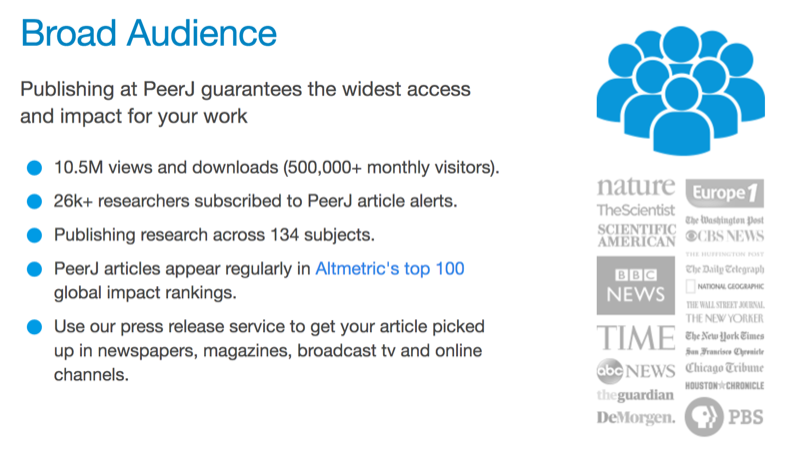Assessing journal quality: Why a broad audience is a step towards tangible impact
lterrat's bookmarks 2017-06-22
Who reads your work and who are you intending to reach in publishing your research? As mentioned in a previous post on how researchers assess journal quality, authors decide where to publish based on a wide variety of determinations of impact, quality, and rigor. Researchers often talk about these determinations under the umbrella term of ‘finding the right journal fit’ for their article. Here we look to explore further what it means to find the right fit in relation to journal audience.
On the LSE Impact Blog, Patrick Dunleavy has grouped the factors authors consider when submitting a journal article into five categories: the scope of a journal; its review processes; open or closed access; coverage, scale and style issues; and the journal’s dissemination and impact. Within the grouping of scope, Dunleavy provides further questions for researchers to consider when selecting a journal such as publication history (how often does the journal publish new articles?), disciplinary coverage (who will be interested in reading your work), and indexing (how will researchers find your work). All of these considerations have to do to some extent with the audience for your journal article.
Audience is an area that we find consistently mentioned in our surveys. And for good reason – researchers want their work read so that they can solicit feedback and the research can make a difference, either in the field or in wider society. Our authors especially value a publication venue with a broad audience. Below we look at what a broad audience means in the age of digital reach and why a broad audience is becoming so important for early career and senior researchers alike.
One of the most tangible benefits to publishing in an open access journal (as opposed to a subscription-based journal available behind a paywall) is the opportunity for your work to be read by new readers. Today’s saturated digital content landscape means the biggest obstacle will always be to get people’s attention. But research behind a paywall creates yet another barrier to views and wider attention.
At PeerJ we are under no illusions as to the difficulty of building an audience engaged in reading the latest scientific findings, especially as academic research tends to be a highly specialized pursuit. An academic audience for journal articles, rather than a far-reaching general public audience, is far more likely for the average study. And it is probably also true that more scholars consult Google Scholar or subscribe to RSS feeds on particular topics of interest rather than browsing journal homepages.
Of course, some research areas are always going to garner more views than others. But regardless of the topic of research, we believe that every scientific article deserves to be shared in a way that finds its audience. Over 32,000 researchers have subscribed to our content alerts already, which means when you publish with PeerJ, your work is being shared directly with an interested and engaged community.
 Sign-up for PeerJ content alerts and get your choice of the latest research sent straight to your inbox.
Sign-up for PeerJ content alerts and get your choice of the latest research sent straight to your inbox.
The scope of a journal should always remain a primary consideration for determining whether an article is a good fit. But in this day and age, research categories can overlap and become blurry. Highly collaborative teams from different institutions and time zones, conducting research across specialties are quickly becoming the norm.
In response to these trends, and to re-emphasize the importance of methodological rigor over the novelty of findings, the ‘megajournal’ emerged as a useful tool for providing a home to match the diversity of research practices. These types of generalist journals, Dunleavy notes, when home to broad disciplines, can attract a far higher readership than many specialist journals. In this way, PeerJ sees itself as a broad community journal – not a hyper-specialised, niche community journal, but instead a widening of what a community journal can be and the audience it can reach. A community of shared values, for researchers, and by researchers.
A final consideration for why researchers might value a broad audience is what this audience, in turn, says about the author. The reason why the Impact Factor has been such a useful (albeit flawed) metric over they years is that it provides a shorthand for promotion, tenure, and evaluation committees to make judgments on a scientist’s corpus of research and specialties. We all hope that decisions are made based on more than a quick glance at a publication list. But in reality, a researcher’s list of publications is bound to at some point play a factor in evaluation. What does your publication list say about you? Beyond vague appeals to prestige, a broad-audience journal like PeerJ demonstrates a tangible and firm commitment to a wide audience which can equally broaden your CV.
Finding the right fit for your journal article is no simple task. What may be the right fit for one study, won’t necessarily be true for the next. Today’s scholars have many options and can gain from a multiplicity of outlets as part of their published repertoire. Broad audience is one particular benefit that we are proud to deliver due to its impact on the wider communication of scientific findings, but we know it is not the only consideration. What matters more is that each researcher is asking what they are looking to get out of their publishing experience and whether their chosen outlet is delivering. Our final piece in this series on journal quality will turn to peer review, the importance of quality in the review process and how journals and researchers might evaluate this going forward.

